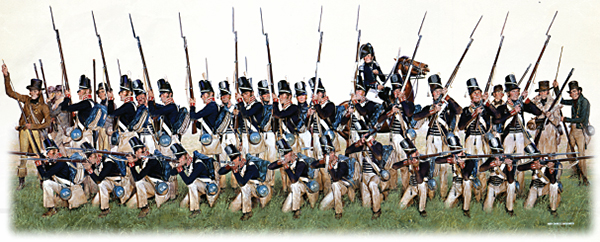
American encampment
Battle of the Châteauguay National Historic Site

American Troop Picture
© Hugh Charles McBarron, Canadian Parks Service
Upon their arrival on October 21 and 22, 1813, the American army officers chose this site for the encampment of their 3700 soldiers. This “advance position” was on cleared land near the Aux Outardes and Châteauguay rivers.
Upon arriving here, Hampton evaluated the defensive position of the Canadian troops on the ground. Guides and informants had kept him well informed, telling him the location of the abatis (felled trees interlaced to obstruct the passage of the invaders), the four defence lines of the troops in reserve, and the eventual addition of new trenches by reinforcement troops. So well that on October 25, Hampton already knew that he would try to encircle these positions.
The departure of Purdy’s troops for the south shore of the Châteauguay River took place not far from the encampment, travelling via a ford. The cart road, on the north shore, enabled him to quickly reach the first defensive line of the British forces.
The Battle of the Châteauguay took place on October 26, 1813, between 10 a.m. and 3 p.m. Major General Wade Hampton’s American troops stayed on the banks of the Châteauguay for seven days. After their defeat, they decamped to recross the border on October 30 and returned to their winter quarters at Four Corners. Salaberry and his men had foiled the intent of seizing Montréal.
It is said that Hampton’s troops left many items behind.
“The Americans abandoned muskets, drums, haversacks, provisions, etc., scattered along Purdy’s route. Later, Salaberry counted 150 muskets and 6 drums.” (V. J. H. Suthren, The Battle of the Châteauguay, 1980).
Battle of the ChâteauguayAn American drum and an American rifle found along the Châteauguay River can now be seen in the museum room at the Battle of the Châteauguay National Historic Site.
Today, the site of the American encampment is private property that in early June each year, hosts the Ormstown Fair (since 1914), an agricultural exhibition highlighting rural life. This property is located at the entrance to the town of Ormstown in beautiful surroundings where the architecture of many of the homes reflect a Loyalist influence. The area encompassing the Ormstown fairgrounds represents only a small part of the actual space covered by the American encampment in 1813.

Overview of the American Encampment Spot
- Date modified :